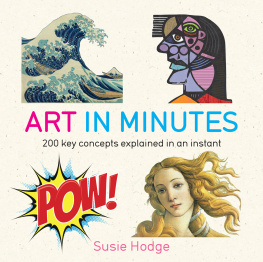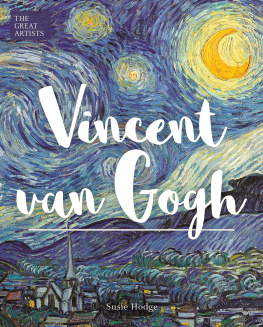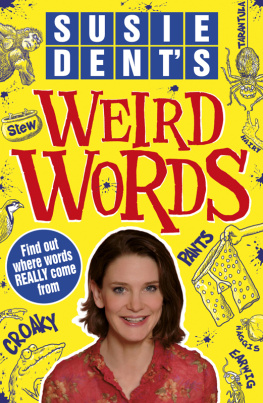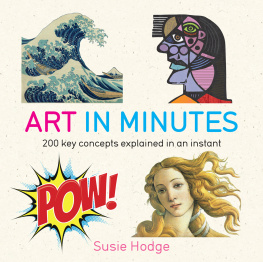Susie Hodge - 50 Art Ideas You Really Need to Know
Here you can read online Susie Hodge - 50 Art Ideas You Really Need to Know full text of the book (entire story) in english for free. Download pdf and epub, get meaning, cover and reviews about this ebook. publisher: Quercus, genre: Religion. Description of the work, (preface) as well as reviews are available. Best literature library LitArk.com created for fans of good reading and offers a wide selection of genres:
Romance novel
Science fiction
Adventure
Detective
Science
History
Home and family
Prose
Art
Politics
Computer
Non-fiction
Religion
Business
Children
Humor
Choose a favorite category and find really read worthwhile books. Enjoy immersion in the world of imagination, feel the emotions of the characters or learn something new for yourself, make an fascinating discovery.

- Book:50 Art Ideas You Really Need to Know
- Author:
- Publisher:Quercus
- Genre:
- Rating:3 / 5
- Favourites:Add to favourites
- Your mark:
- 60
- 1
- 2
- 3
- 4
- 5
50 Art Ideas You Really Need to Know: summary, description and annotation
We offer to read an annotation, description, summary or preface (depends on what the author of the book "50 Art Ideas You Really Need to Know" wrote himself). If you haven't found the necessary information about the book — write in the comments, we will try to find it.
50 Art Ideas You Really Need to Know — read online for free the complete book (whole text) full work
Below is the text of the book, divided by pages. System saving the place of the last page read, allows you to conveniently read the book "50 Art Ideas You Really Need to Know" online for free, without having to search again every time where you left off. Put a bookmark, and you can go to the page where you finished reading at any time.
Font size:
Interval:
Bookmark:
you really need to know

Susie Hodge

Throughout its history, art has had numerous functions and it has always mirrored the times in which it was made. At its simplest, it is a form of communication or decoration, but it has also been created for countless other purposes, such as religious representation, propaganda, commemoration, social commentary, interpretation of reality, depiction of beauty, storytelling or portrayal of emotion. It is often enigmatic, perplexing or even disconcerting, leaving us hard-pressed either to understand or define it.
This book is about many of the ideas that have been behind art, from prehistory to today. It considers art that was produced in certain places at particular times and how an amalgamation of elements, such as traditions, techniques, materials, technology, the environment, social or political events or circumstances and individual personalities, have resulted in some unexpected, inspirational or puzzling innovations. It also focuses on the links between art and a societys activities and aspirations and how the results can sometimes be, for instance, awe-inspiring, shocking, beautiful or downright ugly.
Roughly chronological, the book begins with the earliest art and includes many groundbreaking ideas, including the astonishing creations of the Renaissance, the provocative paintings and sculpture of the 16th century and Japanese pictures of the floating world, for example. It shows how artists from various times, cultures and countries have produced a multiplicity of processes, styles and images and how the role of artists changed over time and across continents. Later sections of the book discuss the explosion of ideas that emerged during the 19th and 20th centuries, from the revolutionary work of the Impressionists and the development of abstract art, to the extensive reactions and reinterpretations that occurred around the two world wars. The final section of the book explores some of the latest notions that indicate some exciting, surprising and unanticipated possibilities for the future of art.
(c.30,0002000 BC)
The idea that art was magic in some way, that it had special powers or could conjure up the spirits was a common belief in many early societies. Few examples of prehistoric art have survived, but those that have been found reveal various social systems and religious ideas that were probably generally understood thousands of years ago and can only be speculated about now.
The beginnings of art precede written records. So it is not known whether the oldest artwork that has been found is typical of its time and periodor even if it was art at all. The earliest work that can clearly be classified as art comes from the late Stone Age and particularly the period between 15,000 BC and 10,000 BC, when humans painted, printed and scratched images of animals, hunting, hands and patterns on cave walls and rock shelters.
The Stone Age is usually divided into four main periods: Lower and Middle Paleolithic c.750,00040,000 BC; Upper Paleolithic c.40,00010,000 BC; Mesolithic c.10,0008000 BC and Neolithic c.80001500 BC. Paleolithic people were hunter-gatherers. Mesolithic and Neolithic people became farmers and so had greater control over their own destinies. Although the styles and subjects of art changed across these periods, the basic idea that artistic creation could be infused with a spell or prediction of what was to come continued.
Cave paintings created about 10,000 to 30,000 years ago in France, Spain, Italy, Portugal, Russia and Mongolia, are some of the most well-known prehistoric works of art. The most astonishing are in Lascaux in south-west France, where about 300 paintings and 1,500 engravings decorate two large caves. Although the artists worked in the shadowy depths of the caves, all the paintings are remarkably vivid and show accomplished skills in rendering perspective, form and motion. It is believed that most of this prehistoric art was produced for rituals and was intended to bring good fortune, or certainly to affect the future for the benefit of society or individuals.
Hall of Bulls
The huge, lifelike paintings of animals, including bison, horse and deer seem to stampede across cave walls and ceilings. All were painted using powdered pigments such as red and yellow ochre, umber, charcoal and chalk, which were crushed on stone palettes and mixed with animal fat before being applied to the cave walls and ceilings with fingers, pieces of bone, twigs, moss or brushes made of fur. Many may have been copied from dead models. The naturalistic rendering, the frequent representation of animals pierced by arrows or spears, the casual overlapping of images and locations in the most inaccessible parts of caves all suggest that the making of these pictures was a magical ritual to ensure success in the hunt.

Cave painting, Lascaux, c.15,000 BC
Fertility and food Supernatural powers were also believed to be imbued into sculpture. The first carvings were made of ivory, stone or clay. Small, rounded limestone female figures, about 11cm high, dating from around 25,000 BC were found in Austria and are known as Venus figurines. These and similar statuettes from other parts of Europe are believed to have been carved to function as fertility icons.
Drawing is still basically the same as it has been since prehistoric times. It brings together man and the world. It lives through magic.
Keith Haring
Power, superstition and religion Interpretations of prehistoric art still vary. Almost certainly viewed as a powerful protection against the forces of nature or evil spirits, multiple footprints have been found in front of many of the cave paintings, indicating religious gatherings. Because Paleolithic paintings of humans are uncommon and unrealistic, it is likely that the artists believed they were capturing spirits through their art. As they needed an influence over the uncertain food supply on which they depended, they aimed to establish good relations with the unseen powers they believed existed around them. The images they created were ways they felt they were controlling their destiny. It is not clear whether they believed in gods or one supreme being, but the idea of supernatural powers being evoked through art was a strong one that lasted for thousands of years.
By the Mesolithic period, artists began painting more on open rock surfaces than in dark caves, the painting became more stylized and people featured more frequently. Representations of the human figure were abstracted and men were often shown as warriors. The Mesolithic idea that the people were controllers rather than victims of their environment meant that they depicted themselves in confident action rather than focusing completely on their prey.
Women artists
It is often assumed that the prehistoric cave painters were men. But what was not imagined was that these experts might also include women. The results of a recent study have indicated that many of the artists were in fact women, which suggests that the female role in prehistoric society was much greater than previously thought.
Function and form During the Neolithic period, life became more stable and people cultivated plants and animals, replacing hunting with plowing. This was the time of great megalith building such as Stonehenge in southern England and Beltany in Ireland, famous for their astronomical alignments. It is not understood how the massive stones were maneuvered and the ideas behind these megaliths are still unclear, especially as they were reused by subsequent generations for different purposes, but theories include healing centers, burial sites, temples for solar and lunar worship, ancestor worship or even vast calendars. Archaeological evidence indicates that Stonehenge, for instance, served as a burial ground for the first 500 years of its existence. The links with the sun and moon have long been understood as humans way of connecting with supernatural powers.
Font size:
Interval:
Bookmark:
Similar books «50 Art Ideas You Really Need to Know»
Look at similar books to 50 Art Ideas You Really Need to Know. We have selected literature similar in name and meaning in the hope of providing readers with more options to find new, interesting, not yet read works.
Discussion, reviews of the book 50 Art Ideas You Really Need to Know and just readers' own opinions. Leave your comments, write what you think about the work, its meaning or the main characters. Specify what exactly you liked and what you didn't like, and why you think so.






